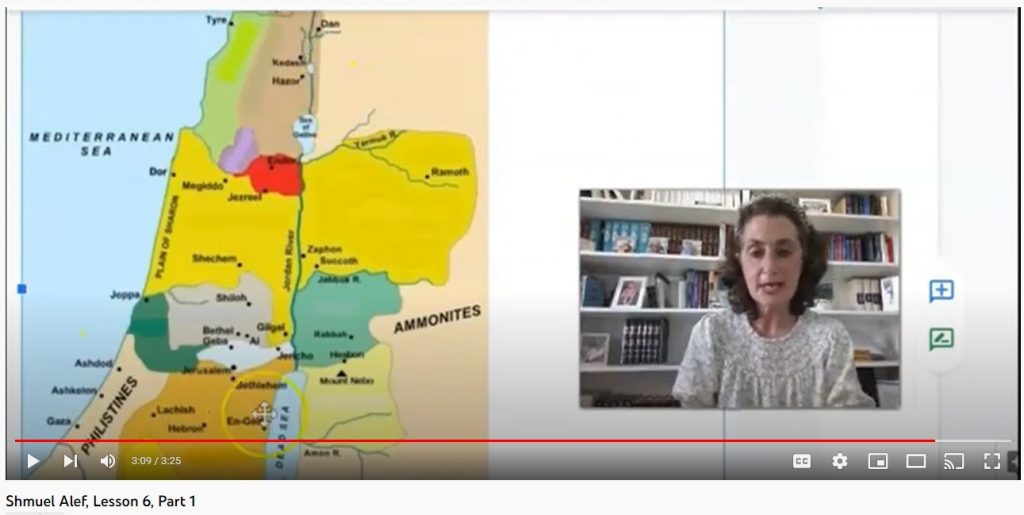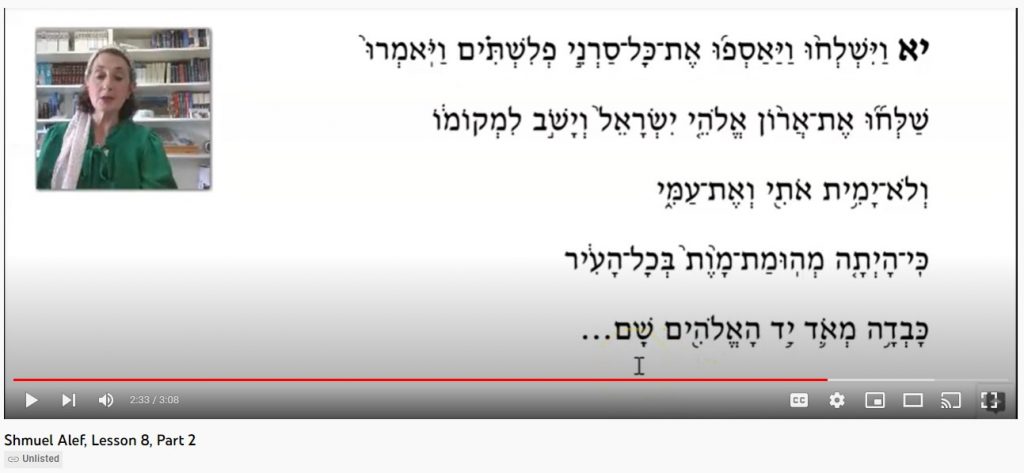At the beginning of Shmuel Aleph, we meet a number of important people in our story. Can you match each person with the passuk that describes him or her?
Play below, or find the game here!
Good luck!
At the beginning of Shmuel Aleph, we meet a number of important people in our story. Can you match each person with the passuk that describes him or her?
Play below, or find the game here!
Good luck!
Kitah is a feature article in today’s eJewishPhilanthropy newsletter. We were featured along with the Gesher homeschooling program.
Thanks so much to Daniela Cohen for her thought-provoking question, and the Kitah parent Suri Kinzbrunner and teacher Rabbi Gavi Ziegler who generously gave of their time to speak about their Kitah experiences.If you’re looking for meaningful learning next year for your child (or know a family that’s looking), reach out to see if Kitah is right for you!


Course Name: The Road to Kingship
Teacher: Mrs. Ariella Nadel
Text Studied: Sefer Shmuel Aleph, Chapters 1-15
For Grades: 5-8
Number of lessons: 20
General Course Description:
In this course, students will learn the chapters of Shmuel Alef from the birth of the prophet Shmuel through the rise of David as future king . We will learn about the process through which the tribes of Israel became a unified nation under a single king.
Our studies will be centered around the main characters of our Sefer: Shmuel, Shaul and David and how their actions impacted the character of our nation.
Students will learn about the criterion guiding the inclusion of a story in TaNakh, Nevuah SheHutzrecha L’Dorot (a story with an eternal message). They will learn how to reflect on each story we learn through the lens of those words -reflecting on how the lessons imparted by these stories were both relevant to the time of Navi and their lives today.
Students will grow more comfortable reading text in the original Hebrew, and navigating through the pesukim and chapters of TaNakh.
Students will learn the following skills during this course:

Students will learn the following Judaic knowledge:

Students will learn come to understand:
Sample Lesson: You can progress through the lesson to get a sense of how we present and organize Kitah materials. To access the sample lesson click here.
Below you’ll find a sample of the sixth lesson in the Navi Shmuel course.
Navi Shmuel Aleph Lesson 6 -Shmuel’s Prophecy
Many Jewish educators teach the famous Gemara from Shabbat that describes the basic mitzvah to light the Chanukah candles, and the debate between Beit Shammai and Beit Hillel about how to perform hiddur mitzvah.
Yet, students can find the basic concepts in the passage confusing. I’d like to share how I taught this lesson, as well as the text of the Gemara.
The Goal of this lesson: Students will understand the three levels of mitzvah performance – Mitzvah, mehadrin and Mehadrin min HaMehadrin, and apply the concept of Hiddur Mitzvah to a mitzvah other than Chanukah.
How do you teach Gemara text without having to read the text? I love Wordwall. So I made a simple matching game to teach the terms found in the passage. Students need to match the Hebrew terms with their English translations (you’ll find a link to the game here.)

After playing the game for a while, we then played the game together, with each student calling out a pair. (I did not keep score, but they would have enjoyed that). This ensured that the students all “played” twice, and understood the meaning of each Hebrew term.
Then, I shared with them a Google doc with the Gemara text in a chart. I asked the students to then highlight the phrases that they recognized from the game. Students quickly realized that they knew almost all of the terms in the piece. Students that worked faster were then asked to begin translating the Gemara.

Then, we focused on the words hadar and hiddur mitzvah. What does it mean that one can (and should) perform mitzvot in a beautiful manner? How do you do it?
We then looked at the three levels of mitzvah performance described in the Gemara (also in the same Google doc linked above):

Now students could understand that on Chanukah, we light only as mehadrin min hamehadrin. You can ask them why they think we Chanukah candle lighting specifically is done in this manner.
Finally, I asked students to name a mitzvah other than Chanukah lighting. In order to check whether they had in fact understood the meaning of hiddur mitzvah, I asked them to descibe how they would perform that mitzvah in a more beautiful manner.
I hope that this is useful and helpful to you! Chanukah Sameach!
Kitah 5783 Google Classroom Links
If you’re a Kitah 5783 Student, you can use this page to access your Google Classroom and any assignments. Click on the banner to access a class.
Are you a parent interested in enrolling your child in a Kitah class (it’s never too late to start!)? Contact Rabbi Spolter.




How does Kitah work? Each video lesson is divided into smaller sections, with questions after each section.
Watch this lesson with your children, and then answer the questions together. You can find other Kitah holiday lessons here.

Lesson Description:
As we look forward to the High Holidays, Teshuvah (Repentance) is on our minds. What is Teshuvah, and how do we do it? In this lesson, we look at the pesukim that teach us about the Mitzvah of Teshuvah, and Rambam’s explanation about the elements of Teshuvah.
I’m very excited to let you know that we’ve opened registration for the coming school year. Kitah learning begins on Monday, August 30th.
Courses:
Kitah students will learn the following courses, which will begin after the Chagim.
Chumash Breishit – The Ten Tests of Avraham Avinu: We’ll learn about our first forefather, and study the stories in the Chumash that formed the basis of the Jewish people. This class is taught by Rabbi Reuven Spolter
Megillat Rut: Learn the story of Rut, and the values that motivated Rut to join the Jewish people. This course, which covers the entire book of Rut, is taught by Mrs. Adina Blaustein of Cleveland.
Mishnah Sukkah: How do you build a Sukkah? What are the Four Minim? What are the basic attributes of each? In this course, taught by Rabbi Spolter, we’ll study the Mishnah and learn halachot surrounding the holiday of Sukkot.
Registration – And Saving Money

Tuition for Kitah at Home:Plus is $189/month – a zero percent increase over last year! Families that register by August 1st will pay just $179/month – a one hundred dollar savings over the course of the school year! (Sadly, there’s no discount for Kitah at Home:Basic early registration).
August-September Schedule
With this in mind during the month of September we’ll send two weekly on-demand classes every Monday related to the Tishrei Chagim. We’ll review what we’ve learned together over Zoom. These classes will give our students a sense of connection to the holidays, as well as some of the texts they’ll see in shul over the chagim. Then, once Sukkot is over, we can begin our regular schedule of classes.
This year the Jewish calendar presents some significant challenges (see the August-September calendar here.). The Chagim take place on many weekdays throughout the month of September. This will make it especially hard for students who are not in Jewish day schools, who will be missing classes, and will need to keep up. Yet, it is very important for students to begin their Jewish learning at the same time that they start school.
How Do You Register?For all returning parents, simply send me an email reply indicating that you’d like to register with the names of the children (and their ages) who will be participating this year. Before the school year begins, I’ll send a new payment link – and we’ll be good to go.
For any new families – please fill in the contact form here: https://kitah.org/kitah-for-home-contact-us.
A Kitah lesson on Modern Medical Ethics

The United States government recently announced that it would support a patent waiver for the COVID vaccine that would allow other companies from countries around the world to quickly produce badly-needed vaccines for the global population. This raises the thorny ethical issue of patents and the right to keep information secret, when that information can save human lives.
A recent article in the Israeli Mekor Rishon newspaper by David Kurzweill addressed this issue in light of a fascinating Talmudic story about the sage Rabbi Yochanan, who used a questionable tactic in order to secure critical medical knowledge.
This story raises questions not only about medical ethics, but also about how we relate to stories about questionable behavior by our rabbis, leaders and teachers.
You can find the source sheets here if you’d like to print them out for your students.
Know a family looking for an excellent Jewish learning option for their Middle School Children? Registration is now open for Kitah for Home for fall 2021.
The Mishnah (Ta’anit Chapter 4 Mishnah 6) teachus us that five tragic events took place on the 17th Day of Tammuz for which we fast each year. Can you match them together? Once you’re done, can you explain each one?
You’ll find the game here!
Good luck and have an easy fast!